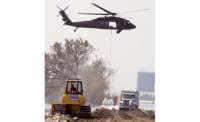The next time there is a levee breach in San Joaquin County, Calif., Ronald Baldwin, the county’s director of emergency operations, would like to have some huge rubber tubes pre-positioned at Interstate underpasses, rail embankments and other strategic locations to contain flooding.



Baldwin was sold on the technology of using large, air- and water-filled PVC-coated, polyester-fabric tubes for flood control after seeing them in action on Nov. 9 at the U.S. Dept. of Agriculture’s Hydraulic Engineering Research Unit in Stillwater, Okla. The tests and demonstrations were conducted by the Dept. of Homeland Security’s Advanced Research Projects Agency, Washington, D.C., and the U.S. Army Engineer Research and Development Center, Vicksburg, Miss.
The work is building on trials conducted last year in which ERDC proved, at a 1:4 scale, that tubes can seal breaches within minutes. “Our objective is to set a system within four hours, from go to close,” says Donald Resio, ERDC’s senior research scientist.
USDA’s 100-acre outdoor laboratory is the only site in the country with sufficient water flow for the tests—125 cu ft per second for 10 to 15 minutes. The supply is siphoned from the adjacent, 3,000-acre Lake Carl Blackwell.
This year, ERDC again showed how a 5-ft-dia., 28-ft-long “portable lightweight universal gasket,” or PLUG, can seal a levee breach. The compressible nature of air and the incompressible nature of water, which partially fills the tubes, makes the PLUG conform to a breach and then go rock solid when the flood tries to force them through. Also demonstrated was a system of tubes, sheets and ballast used to create protective spillways for permitted overtopping. Presentations explained research on techniques for air-dropping tubes into breaches and on deployment issues like weather, flow, differing levee sizes, slopes, soils and other variables.
All the tubes tested are manufactured by Kepner Plastics Fabricators Inc., Torrance, Calif. They are made with PVC-coated polyester fabric, 0.031 in. thick, with a dry weight of 26.5 oz. per sq yd.
A new device demonstrated is an arch-shaped tube for creating either a large stopper or a cofferdam. The cofferdam could be deployed to establish a dry workspace after a PLUG seals a breach, Resio says. The arch barrier demonstrated was a 42-ft by 31-ft arch made of 5-ft dia. tube. Resio says arch barriers could be used for repairs to locks and dam gates that are often delayed for weeks until people can access the site. In large-scale applications such as plugging waterways, the ends of the arch would need to be anchored to the banks. During earlier laboratory tests, two tubes popped from pressure, so a pillow tank was added in the field trials to support the inside radius. Resio says smaller arch tubes may be useful for keeping storm surge from surface openings of New York City subways.
Attendees also saw a floating sensor system being tested by the Lagrangian Sensor Systems Laboratory at the University of California Berkeley, the Lawrence Berkeley National Laboratories and the California Dept. of Water Resources. “When a levee breaks, you do not have time to go back to the office and run a computer model,” says Alexandre Bayen, assistant professor of civil and environmental engineering at UC Berkeley. Scheduled to be operational in 2010, the floating sensor network will deliver estimates of water flows in real time via the Internet to flood managers, Bayen says.
More Testing
The Mississippi Emergency Management Agency has shown interest in pre-positioning some tubes along Mississippi River levees, says William Laska, program manager for the DHS’s research agency’s science and technology directorate. But Laska says officials in flood-prone areas will have to wait at least a year for testing to be finished. Also, questions of deployment still need answers. Without concepts of operation, including training for deploying tubes and engineering for appropriate shape, size and proper positioning, the tubes are not ready to be used for emergency repairs, Laska says.
“You have to have someone who knows what to do with it and the brain power to get it done,” Resio says. “And you cannot train on scale for real-life, practical use.”
Further, the ownership, storage, transport and deployment of the tubes remain open questions. Will it be...




